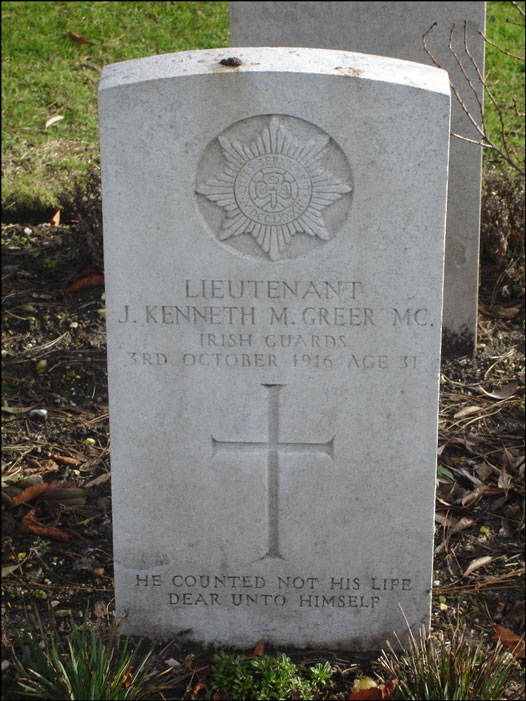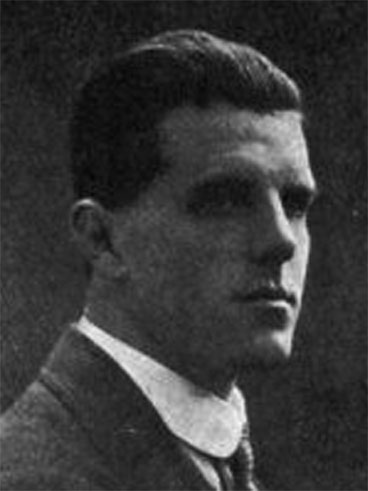![]() In memoriam
In memoriam ![]()
Lieutenant James Kenneth MacGregor Greer, MC

James Kenneth Macgregor Greer was born at Westoncrofts, Ballymoney, County Antrim, on 11 January 1885, son of county solicitor Thomas Macgregor Greer and his wife Margaret Baines Greer (nee Reed). He was educated at Highgate School and Trinity College, Dublin, and was studying for law as an apprentice in his father's firm when the war began.
On 13 August 1914 he enlisted in the North Irish Horse (No.1006), joined a few days later by his friend Leslie Ernest McNeill. They embarked for France as part of C Squadron just a week later, seeing action in the Retreat from Mons and Advance to the Aisne. His commanding officer Lieutenant Barrie Combe wrote on 24 September in a letter to his wife:
Greer [&] McNeil the two gentlemen recruits who you saw at the Northern Counties Hotel have proved a great success. They are two of the best men I have got. Also I have a son of Dr Darling in my Troop and a young Coey – all good men.
On 7 December 1914 Greer was commissioned in the field as a 2nd lieutenant and posted to the 3rd (Prince of Wales) Dragoon Guards. On 15 March 1915 the Belfast News-Letter carried the following story:
News to hand shows that a Ballymoney officer, Lieutenant Kenneth M. Greer, ... has had a thrilling experience in the trenches. Having been engaged for about a week in the advance trenches, one afternoon a bullet from the enemy struck the peak of his cap, passed through his hair, and pierced the back of his cap without injuring him in any way. Lieutenant McNeill ... who was near at the time, was shown the cap, and it was resolved to keep it as a memento.
The following month Greer was attached to the 1st Battalion, Irish Guards. He was with the Guards on 18 May 1915 at the Battle of Festubert when he was severely wounded, suffering multiple shrapnel wounds. The wounded officer was shipped to England where he was admitted to the 3rd London General Hospital at Wandsworth.
He recovered quickly and in November returned to France, where he was transferred to the Irish Guards as a regular officer.
January 1916 brought three pieces of good news. Greer was Mentioned in Despatches, awarded a Military Cross for gallantry at Festubert, and promoted to the rank of lieutenant.
On 15 September 1916, on the first day of the Battle of Flers-Courcelette, Greer was again seriously wounded. There are two somewhat different accounts of what happened. According to Private Joseph Doherty:
On the morning of the 15th September last we were at Ginchy and our objective was a small village called Flers. The Coldstreams led the attack and we followed and the supports were the Scots Guards and the Grenadiers. When we got to the first line of the enemy trenches we stopped a few minutes. Lieut Greer then led us to the second line of trenches. He had a revolver in one hand and a stick in the other, and rushed in front pointing his stick towards the enemy, and shouting to us to come on. It was between the trenches he got hit in the head, and fell. He gave his revolver to Sergeant Hugh Carton and told him to 'carry on'. Carton then told us to follow him, and that we did, right into the German third line.
However a fellow-officer wrote:
It was his splendid fearlessness which gained him his wound. We were trying to get a Lewis gun on a German machine gun, which was playing on the trench we had captured. Two having jammed, J.K., as we always called him, seeing another some way down the trench, set off to fetch it. As the trench was crowded and impossible to get along, he simply sprang up on the parapet and walked along the top. Here he was shot by a sniper.
Greer was evacuated to No.2 Red Cross Hospital at Rouen, suffering from a head wound and fractured skull. The news was telegrammed to his father. When ‘other ranks’ were wounded and in hospital, permission for relatives to visit was routinely refused. It was different for officers, and arrangements were made for Greer’s mother and a Miss Enid McNeill to travel to France. However before they could leave another telegram came which simply stated:
Deeply regret to inform you that Lieut. J. K. Greer Irish Guards died of wounds 12.50 p.m. October 3rd. The Army Council expresses their sympathy.
Lieutenant Greer was buried in St. Sever Cemetery, Rouen, Seine-Maritime, France, grave A.11.2. His gravestone inscription reads:
LIEUTENANT
J. KENNETH M. GREER MC.
IRISH GUARDS
3RD OCTOBER 1916 AGE 31
HE COUNTED NOT HIS LIFE
DEAR UNTO HIMSELF




Bronze plaque in the reception of Greer Hamilton & Gailey, Ballymoney
Gravestone image kindly provided by Steve Rogers, Project Co-ordinator of the The War Graves Photographic Project, www.twgpp.org. Plaque image and first image of Greer kindly provided by Peter Brown of Ahoghill. Quote from Private Doherty from Robert Thompson's book Ballymoney Heroes. Second image of Greer from De Ruvigny's Roll of Honour. Third and fourth image of Greer sourced from the South Dublin Library Service's Our Heroes site http://ourheroes.southdublinlibraries.ie/

